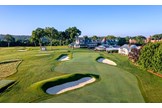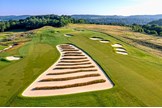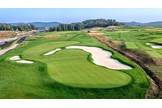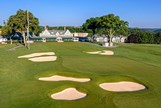Why Oakmont’s brutal beauty will punish the best at the 2025 US Open
Last updated:
In an age when superlatives are too easily thrown about, Oakmont is a course deserving of iconic status. Michael Catling and Tony Dear detail its history and the challenge it poses for the field of the 2025 US Open.
Nick Dougherty was still a fledgling tour pro when he fired a two-under-par 68 in the first round of the 2007 US Open at Oakmont to hold the outright lead. You’d have thought he would have been thrilled, full of confidence after becoming just the second man to break par all day. Instead, he headed straight to the range, unsure how he’d managed to shoot such a number. “My short game got me out of a lot of trouble,” he admits. “I took just 11 putts on the back nine.”
Jump To: Oakmont’s Key Holes
Dougherty spent three hours beating balls that Thursday evening, leaving only when he felt his swing was where it needed to be to maintain his position at top of the leaderboard. He woke Friday morning feeling confident and, sure enough, he hit the ball much better than he had 24 hours earlier. But he shot 77 and fell out of the top 10. “Oakmont is an amazing course, but it’s so exacting,” he says. “Carry the ball a few feet too far onto the green and it catches a slope and ends up in a place where it’s virtually impossible to get up-and-down. Or run through the fairway by a yard and, if you find it, you’ve just got to hack it out. It can be barbaric.”
The silver lining following Dougherty’s struggles on Friday was that he completed 36 holes in the same number of strokes as Tiger Woods. Doing so earned him a third-round tee time with the World No.1, who proceeded to miss one fairway and green all day. “It was brilliant,” Dougherty recalls. “The best round I ever saw. If his putting had been just a little better, he would have shot a lot lower than the 69 he ended up with.”
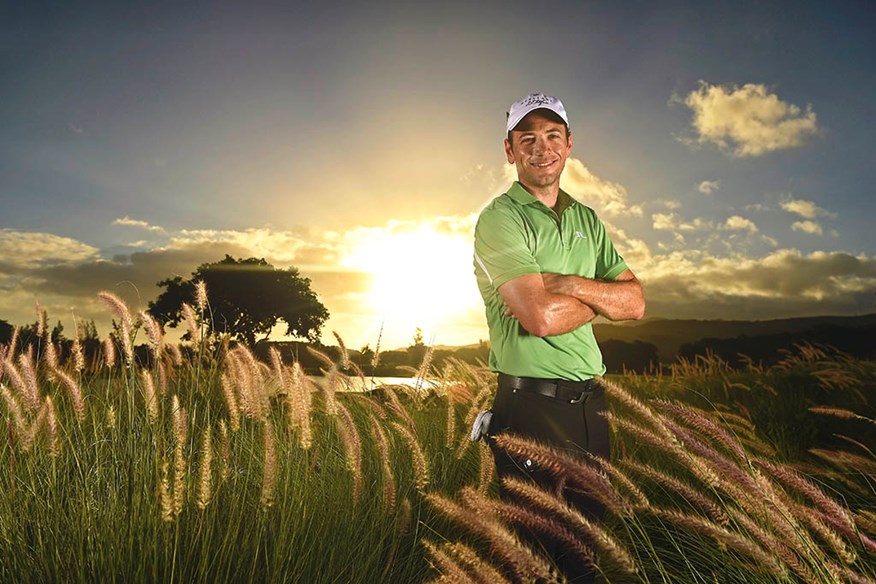
Dougherty returned a 74 and followed it up with a creditable 71 on Sunday to finish in a tie for seventh on 10 over par, five back of the eventual winner, Angel Cabrera. He obviously has nice memories of recording his first and only top 10 in a Major at Oakmont, but he doesn’t remember having much fun.
“When I saw the course for the first time, I just thought, ‘This is going to be as much a battle of nerve and patience as it is skill’. That’s the case at most Major Championships, but it was especially true there. At a course like that, it’s extremely difficult to keep your emotions in check and remain composed.”
Oakmont’s origins
Oakmont has never had much of a pretty face. But what it lacks in trees, dog-legs, and water, it makes up for with an ability to truly test and identify the best golfers in the world. Gene Sarazen, Bobby Jones, Sam Snead, Ben Hogan, Jack Nicklaus, and Ernie Els have all won there, so it’s really no surprise that the USGA are bringing the US Open back to Oakmont for a record 11th time next month.
The course’s staying power owes a lot to the foresight of retired industrialist Henry Clay Fownes, whose dream it was to design an inland-style links that could set a new standard for difficulty. Aided by 150 hands and two dozen horses and mules, Fownes financed and carved the course from 200 acres of exposed farmland on a plateau overlooking the Allegheny River, 14 miles northeast of Pittsburgh.
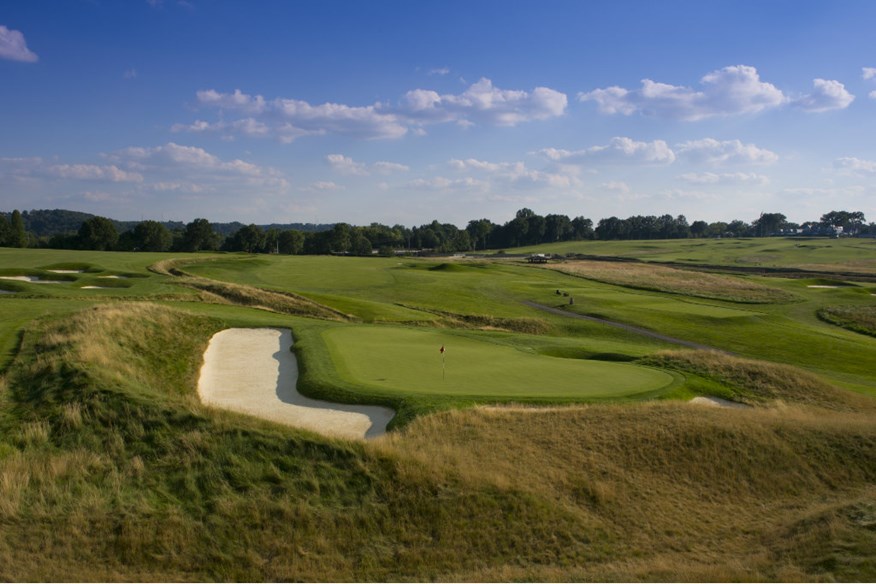
Realising the solid, rubber-cored Haskell ball invented just five years before was likely to revolutionise the game, Fownes wisely chose to make Oakmont as much as 30 percent longer than others of that era. When the course opened in October 1904, it measured over 6,400 yards, with eight par 5s, one par 6, and a total par of 80. It was awarded the first of four national championships just 15 years later and was soon spoken about in the same hushed tones as St. Andrews. Few disputed that it was far tougher.
“HC Fownes was not a course architect, but he was a bright guy and wanted a tough test for himself,” says Marino Parascenzo, who wrote a book on Oakmont ahead of its centenary anniversary. “He didn’t build Oakmont as a real estate investment, nor as a monument to himself. He wanted a real course and club, not a high-society playground with polite tea-party golf. I think he intended it to operate much like a British golf club.”
A son’s vision
The nature of the club has long been a sensitive subject over the years. Fownes envisioned a group of devoted golfers playing a challenging course, then retiring to the clubhouse for cards and whisky; basic, simple, unambiguous.
William Clark (WC) Fownes, who took over Presidency of the club after his father’s passing, also favoured a band of keen golfers committed to upholding the club’s singular philosophy. He lived in the clubhouse during the summer and walked the course every morning, conceiving alterations he felt his father would have endorsed. “A shot poorly played should be a shot irrevocably lost,” was one of his favourite lines. “Let the clumsy, the spineless, the alibi artist stand aside,” was another.
With the help of greenkeeper Emil Loeffler, WC was constantly beefing up the test, turning Oakmont into a model of penal course architecture with some of the slickest, most maddening greens in golf. They once moved the great Sam Snead to scoff, “I put a dime down to mark my ball, and the dime slid away.”

His son might have pushed the course’s playability envelope a little far, but HC would probably have welcomed the additions. And no doubt both men would have smiled when, in the lead up to the 1962 US Open, New Yorker magazine writer Herbert Warren Wind described the course as an “ugly old brute”. Some members were seriously put out, however. They certainly didn’t like being associated with a course regarded as ugly.
Shortly after that US Open (Jack Nicklaus’ first Major victory), Fred Brand Jnr, a prominent member, took it upon himself to ‘beautify’ the course. He instructed architect Robert Trent Jones to plant 3,200 trees, including pin oak, crab apple, flowering cherry, and blue spruce, transforming Oakmont into more of a traditional American parkland than the exposed original. Writing for golfclubatlas.com, then-superintendent John Zimmers said Oakmont nearly became a “pretty parkland course – a description that surely would have HC Fownes and his son William Fownes spinning in their graves.”
By 1990, however, everything changed again. A new generation of members on the club’s green committee were not especially keen on the number of the trees, thinking they negatively impacted the course’s shot values and the quality of its turf. They lobbied the greens chairman for their removal and eventually got their wish when then-superintendent Mark Kuhns commissioned a team of 12 undercover workers to begin a covert clearing operation.
Guided only by the headlights of buggies, their days would begin at 4 am to avoid detection by tree-loving members. Huge tarps were spread out to collect the fallen limbs. High-powered vacuums would then suck up the leaves, while chippers and stump grinders would get rid of the evidence. More than 500 trees were felled before members clocked on and considered it a chainsaw massacre. Some even threatened the club with lawsuits; others branded Kuhns ‘The Butcher of Oakmont’ to his face.
With the membership divided, it took years of politicking and quiet persuasion for the majority to come round to the idea of returning the course to its windswept, links-style roots. “The issue was never about the virtues or liabilities of trees,” said one Green Committee member. “Our sole motivation was to reclaim the Fownes’ legacy and protect his vision for the golf course.”

A treeless terror
Now, with very few trees remaining, Oakmont is back to its, at times, cruel best. Although over 300 miles from the Atlantic Ocean, firm playing surfaces and significant contours do give it the look and feel of a links. There are no streams or burns to speak of, but 11 holes now have dry drainage ditches cutting through them. It fits with Fownes’ philosophy that poor shots should have significant consequences.
“If you hit a shot offline at Oakmont, there’s going to be some type of penalty, whether it’s a half stroke or a full stroke,” says Michael McCormick, the club’s Grounds Superintendent. “There’s not much margin for error there and I think the golf world will see rough that’s probably more penal than they’ve seen in quite some time.
“With the ditches, there are some areas where the fescue grass is pretty dense and there’s some areas where it’s pretty thin. Ultimately, the lies are intended to be somewhat inconsistent. You could see players standing on the side of a ditch, leaning over, trying to pick that thing out.”
Added to the difficulty is the tilt and lie of the land, where nine of the holes force players to hit blind or semi-blind shots. This year, the course will play to 7,372 yards – a 153 yards increase on 2016 – with both par 5s playing well in excess of 600 yards. There’s even the very real possibility of seeing players hit driver on the par-3 8th, which will almost certainly stretch to 300 yards for one of the four rounds. Scott Langley, Senior Director of Player Relations at the USGA, is of the opinion that Oakmont is capable of “bogeying you to death”, especially now the course’s defence has just been stiffened by architect Gil Hanse.

“There are a few different iterations of Oakmont, but generally speaking, they’ve always made adjustments to the course to make it play harder,” says Langley, who will help with setting up the course. “What Gil did, he went back and looked at all the historical drawings and photos and really brought to life the greatest hits of the golf course. A good example of that is the par-4 7th.
“Many years ago, the 7th was just a single lane tee shot with bunkers left and right. Now, Gil has given players a choice standing on that tee, whether to take on a longer carry to cover a cross-section of fairway bunkers on the left, or to lay back a little bit more to the right half of the fairway, staying short of the fairway bunkers. The consequence of doing that is that you actually can’t see the putting green from that right side of the fairway, so it’s an interesting choice to make. But that’s what Gil has done. He’s brought back a lot of optionality, kind of like a multiple choice, on several of the holes.”
Green graves
To address the issue of players hitting down adjacent fairways, a new trend that emerged during the 2021 US Amateur, new mowing lines and bunkers have been added between holes to discourage cross country golf. These changes serve as an addendum to a wider restoration project, which has seen every bunker rebuilt and, in some cases, relocated to align with the original, architectural intent. As for the greens, all 18 have been expanded to allow for more varied pin positions, most notably on the par-3 13th, where options have increased from two to six.
“The greens are the greatest defence on the course, without a doubt,” adds McCormick. “For member play, we present greens that are in excess of 14 on the stimpmeter and the same will be true for the US Open in June. They are certainly larger now than they have been in past Championships, but the optionality with different hole locations means we can put the pins a lot closer to the perimeter of the greens, which brings a lot more hazards into play.
“Before we did the restoration, you kind of had these back stops on greens so if you were hitting a bunker shot, you had these slopes behind the pin to slow that ball down or spin it off of. Now, everything’s flat so going from bunker to bunker or chipping through the green is lot more possible than it was when Dustin Johnson won in 2016.”

While it’s true that rain contributed to slightly lower scoring that week, it’s also worth noting that only two players broke par each day when the course was running fast and firm in 2007. Langley doesn’t want to predict what scenario may play out this time, but unless Oakmont gets an inch or more of fairway-widening, green-softening rain in the build-up, it’s easy to conclude that all 156 players in the field will share one common goal: survival. The hope this time is that it doesn’t end in another ugly rules controversy.
“In terms of raw material, Oakmont is one of the toughest venues that we play for the [US] Open,” says Langley. “The golf course is very well bunkered and you’re definitely going to see more of that classic US Open set-up of thick rough, narrow fairways.
“So it really is one of those places that just tests your game through the entire bag because even if you do hit a bunch of fairways, the putting greens are still very severe and it’s difficult to get the ball close to the hole.
“How that impacts scoring is probably more dependent on the weather. Our goal is to present a complete test, and one that’s worthy of a US Open. There’s a certain level of letting the chips fall where they may, but I think the DNA of the course means pars are going to be really good scores.”
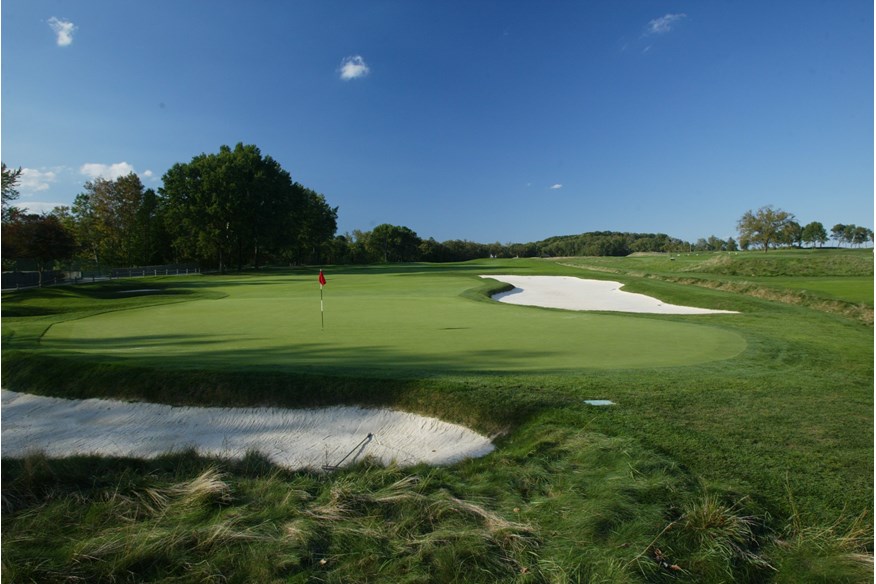
What the pros say…
Rory McIlroy: “One of the real challenges about the golf course, especially after they’ve taken so many trees away, is it’s a big, wide open space now, and you’re hitting into these tight fairways, and there’s not really a whole lot of definition out there. So you have to be so zoned in to where you want your targets to be. You could go a whole round without hitting it at any pin. I’d much rather have a 30-foot putt up the hill on these greens than even an 8-footer down the hill.”
Phil Mickelson: “There’s no reprieve off the tee, there’s no reprieve into the greens, and there’s certainly no reprieve on the greens. The greens are way more difficult to putt on than Augusta’s because of where the hole locations are, they’re pitched twice as much, and the green speeds are comparable.”
Where the 2025 US Open will be won and lost
Hole 1 | Par 4 | 289 Yards | 2016 Stroke Avr: 4.45 (1)
Nothing says ‘Welcome to Oakmont’ quite like this brutal opener, which is responsible for five of the seven highest 1st hole scoring averages in US Opens since 1970. The fairway stretches just 24 yards across and is flanked by deep bunkers, five to the left, two to the right. At 330 yards from the tee, the driving zone drops down towards a terrifyingly slick green that slopes severely from front to back, right to left. The front hole locations are so diabolical that members have been known to use their putter from 50 yards out. As for the pros, more doubles were made here than birdies in 2016.
Hole 3 | Par 4 | 462 Yards | 2016 Stroke Avr: 4.32 (7)
A bucket list hole for some, but a nuisance for others. The famous Church Pews bunker flanks the left side, but the five, deeper bunkers on the right are hardly a blessing. The second shot plays blind to an elevated green that slopes gently away from the fairway, to a swale over the back. Anything short will catch the false front and may roll back down the hill. Now you can understand why 33 double bogeys or worse were made here in 2016.

Hole 8 | Par 3 | 289 Yards | 2016 Stroke Avr: 3.30 (8)
Paul Goydos once called this monster par 3 the only place in championship golf where you could hold a longest drive and nearest the pin contest at the same time. He was only half joking. Last time out, only 24 birdies were recorded from 444 attempts as the hole set-up ranged from 247 yards to 299 yards across the four rounds. It shouldn’t play any longer this year, but don’t be surprised to see players hitting driver if the wind gets up. The entrance is generous, but anything left is likely to find the Sahara bunker, which is 75 yards long.
Hole 9 | Par 4 | 472 Yards | 2016 Stroke Avr: 4.43 (2)
A blind tee shot, a severe ditch looming left, and four pot bunkers on the right make this one of the toughest driving holes in golf. Usually played as a par 5 for members, the 9th is also home to the largest putting green on the course at 23,000 sq ft, almost four times the PGA Tour average. It’s so big that the back half doubles as a practice green, right in front of the clubhouse, during the Championship week. Bogeys are understandably common.
“The hardest par 4 I’ve ever seen in my life is the 9th hole. Theoretically, it’s a par 5. They just slapped a 4 on the card. If you miss it left, you’re in the hazard. If you miss it right, you’re in the bunker and you’re wedging out. You have to hit the fairway. When you hit the green, you have one of the most difficult two-putts of any green out here in any golf course we play.” Phil Mickelson, a six-time US Open runner-up.

Hole 17 | Par 4 | 312 Yards | 2016 Stroke Avr: 3.89 (18)
A frequent graveyard of wannabe winners, this uphill dog-leg left is easily drivable but fraught with danger. It’s a 285-yard carry to clear an intermediate section of bunkers, but the green sits perched on a ridge and repels balls towards the bunkers 10ft below. The deepest – ‘Big Mouth’ – sits in the front right. Miss left, and some of the thickest rough on the course is waiting for you – as Jim Furyk found out to his cost in 2007. He bogeyed the hole during the final round and went on to lose by a single stroke. Tiger did the same from Big Mouth.
“Seventeen is such a great 71st hole because it can offer you the opportunity to play catch-up, but it’s certainly no guaranteed birdie or even par. Laying up, it’s such a precise wedge shot from the centre of the fairway. The way the green is angled, how tight they’re going to tuck the pins, you have to hit such a precise wedge shot to make birdie in there.” Justin Rose, 2013 US Open champion.
Hole 18 | Par 4 | 502 Yards | 2016 Stroke Avr: 4.32 (6)
Ranked as the hardest hole in 2007, this grand finishing hole plays downhill to an offset fairway that condenses 280 yards from the tee. A large expanse of sand intersects a nasty ditch on the left, with three more bunkers lurking on the right. The second shot plays uphill to a large, two-tiered green that slopes from top to bottom quite drastically. In 2007, the average score was 4.60, and just 33% of the field hit the green.
“The 18th hole at Oakmont is really interesting because it’s a long par 4 that gets tighter as you get closer to the green. This can make you want to hit a conservative drive, but then the problem you have is a longer shot into a green that is very severe and slopes heavily from back to front. It’s a question all golfers often face: do I lay it back and catch the fatter part of the fairway but have a long iron in, or do I attempt a more risky drive up the throat of the hole to give myself a better opportunity with a scoring iron?” Jim Furyk, runner-up at Oakmont in the 2007 US Open.




